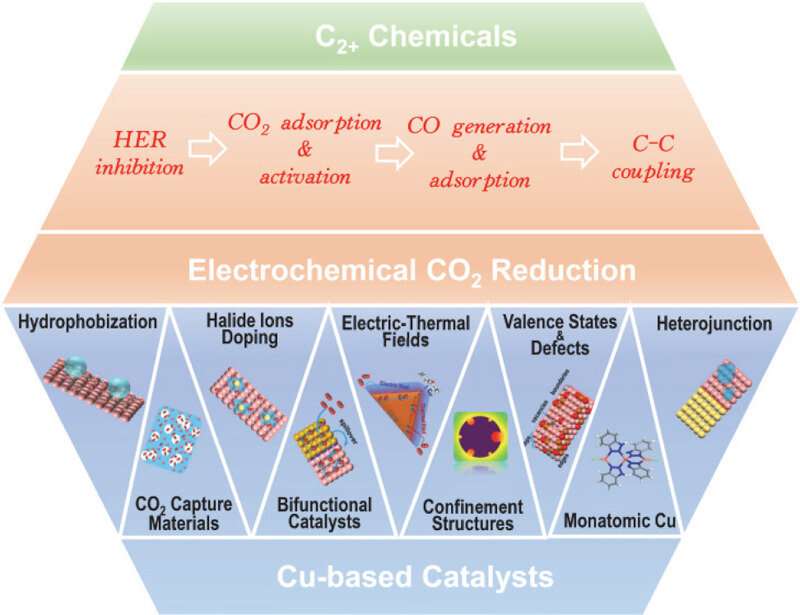This article has been reviewed according to Science X's editorial process and policies. Editors have highlighted the following attributes while ensuring the content's credibility:
fact-checked
trusted source
proofread
An efficient strategy to promote novel products on Cu-based catalysts

The electrochemical CO2 reduction reaction (CO2RR) to high-value-added products with two or more carbons (C2+ products) provides a viable strategy to close the anthropogenic carbon cycle and increase economic efficiency. Cu is generally considered to be the most effective active metal that exhibits notable catalytic performances for CO2RR-to-C2+.
The rationally designed Cu-based electrocatalysts for CO2RR have been extensively developed. However, direct conversion of CO2 to C2+ products with high selectivity and efficiency is still a formidable challenge because of complex reaction networks. In particular, precise control of the products to a specific C2+ product with high selectivity has not been achieved.
So far, it still lacks the systematic guiding laws of catalysts surface regulation to improve C2+ productivity. This is needed to deeply get insight into the reaction mechanism of CO2RR-to-C2+ on surface and/or interfaces. Thus, a comprehensive review covering achievements on surface state modification, which could influence the catalytic performances, for high-efficiency CO2RR-to-C2+ is high desired.
Recently, a research team led by Prof. Qun Xu from Zhengzhou University, China, summarized the recent advances in surface engineering of Cu-based catalysts from four crucial steps in CO2RR-to-C2+:
- Inhibition of HER. Modification with organic molecules on Cu-based electrodes surface enhances the hydrophobicity for inhibiting HER. Another way for this goal is designing specific morphology of nanoneedle shape and hydrophobic porous structure for reducing the surface wettability.
- CO2 adsorption and activation. Cu-based catalysts supported by CO2-capture materials can potentially form a local microenvironment with high CO2 concentration. While, introducing halide ions can donate lone-electron pairs to the unoccupied orbital of CO2 to facilitate its activation through the formation of the CO2•– radical. In addition, synergistic effect between Cuδ+ and Cu0 in Cu surfaces is also efficient to activate CO2.
- CO formation and adsorption. The effective methods include addition of foreign component served as CO-generation sites and construction of specific structures with enhanced local electric-thermal fields. They can efficiently modulate the CO coverage, adsorption capacity and adsorption configurations for C−C coupling.
- C−C coupling. This step can be promoted through constructing confinement structures, adding oxidation states, building defects, designing single-atom catalysts, and constructing heterojunction structures. Cu-based electrode with confinement structure can prolong retention times of intermediates.
Introduction of positive valence Cu sites, defects and heterojunction interfaces mainly modulate the adsorption behaviors of C1 intermediates and lower the energy barrier of C–C coupling. The ligand groups in single-atom catalysts affect the C–C coupling path between different C1 intermediates through modulating the coordination micro-environment of Cu sites.
In addition, this work gives insight into the reaction mechanism of CO2RR by deeply understanding the relationship between surface properties of Cu-based catalysts and improved performances. Meanwhile, the current challenges and potential strategies of CO2RR-to-C2+ are envisioned. The work was published in Chinese Journal of Catalysis.
More information: Huanhuan Yang et al, Efficient strategies for promoting the electrochemical reduction of CO2 to C2+ products over Cu-based catalysts, Chinese Journal of Catalysis (2023). DOI: 10.1016/S1872-2067(23)64429-8
Provided by Chinese Academy of Sciences





















